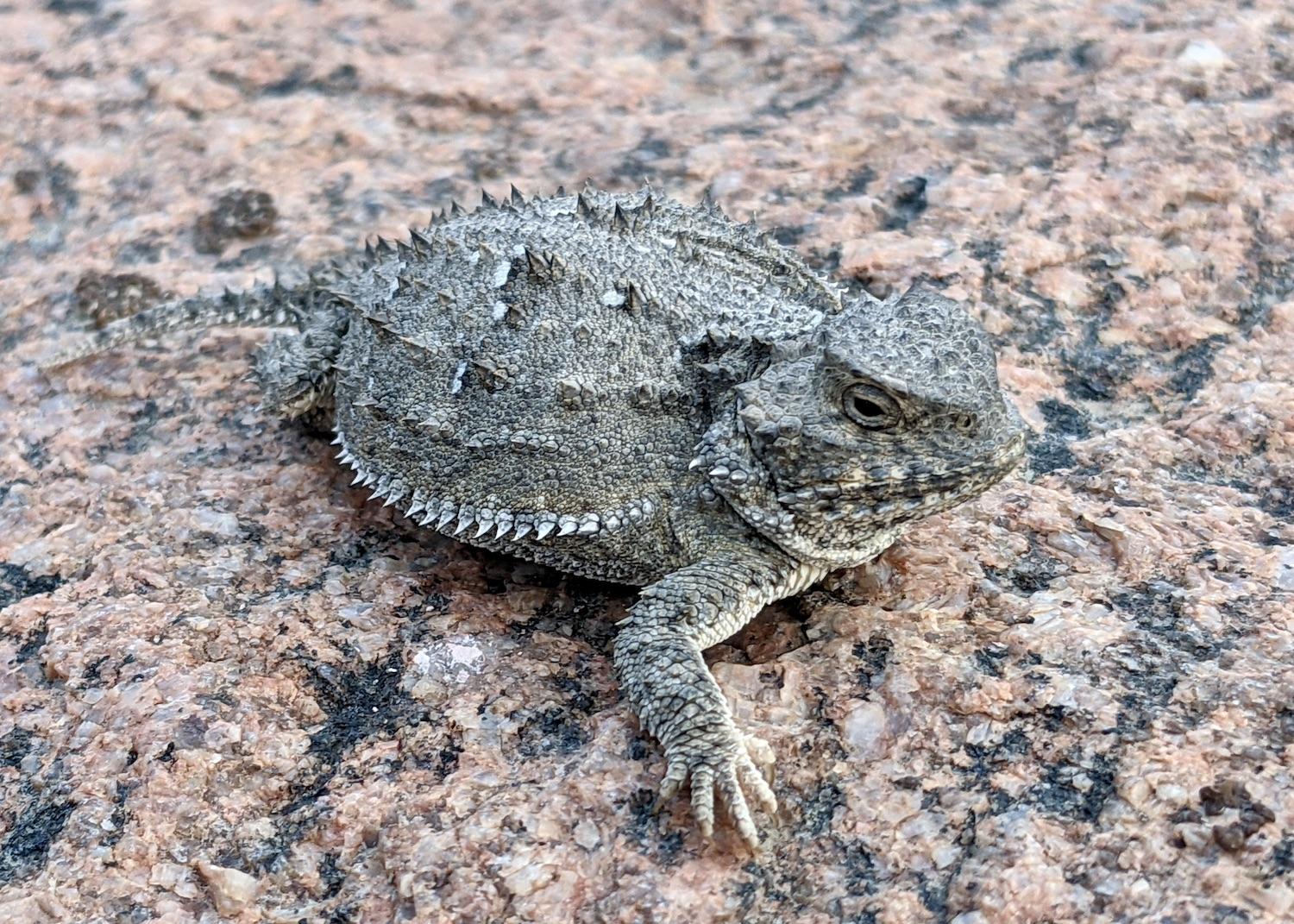
The Greater Short-horned Lizard is the only lizard species found in Alberta and Saskatchewan. The species occurs farther north than any other iguanid lizard species globally and is shown here in Grasslands National Park/Parks Canada
The hunt for Greater Short-horned Lizards in the bearpaw shale of Grasslands National Park gets off to an inauspicious start on a cool September day as the sun fights to break through the clouds.
“I’m sure you realize this is not a great day for reptiles,” wildlife ecologist Stefano Liccioli warns after realizing the temperature is just 15C (59C). “The time of the year isn’t the best and the weather doesn’t help.”
The endangered lizards that live here along the Eagle Butte Loop Trail like to hang out on sparsely vegetated, south-facing slopes dotted with low-lying creeping juniper, their pale bodies camouflaging perfectly with the friable (crumbly) soil.
“If you see lizard say `lizard’ and stop,” says Liccioli. “Most likely the lizard won’t see you. If you hear rattling, stop. Don’t panic. Don’t jump. Don’t start running. That is a rattlesnake.”
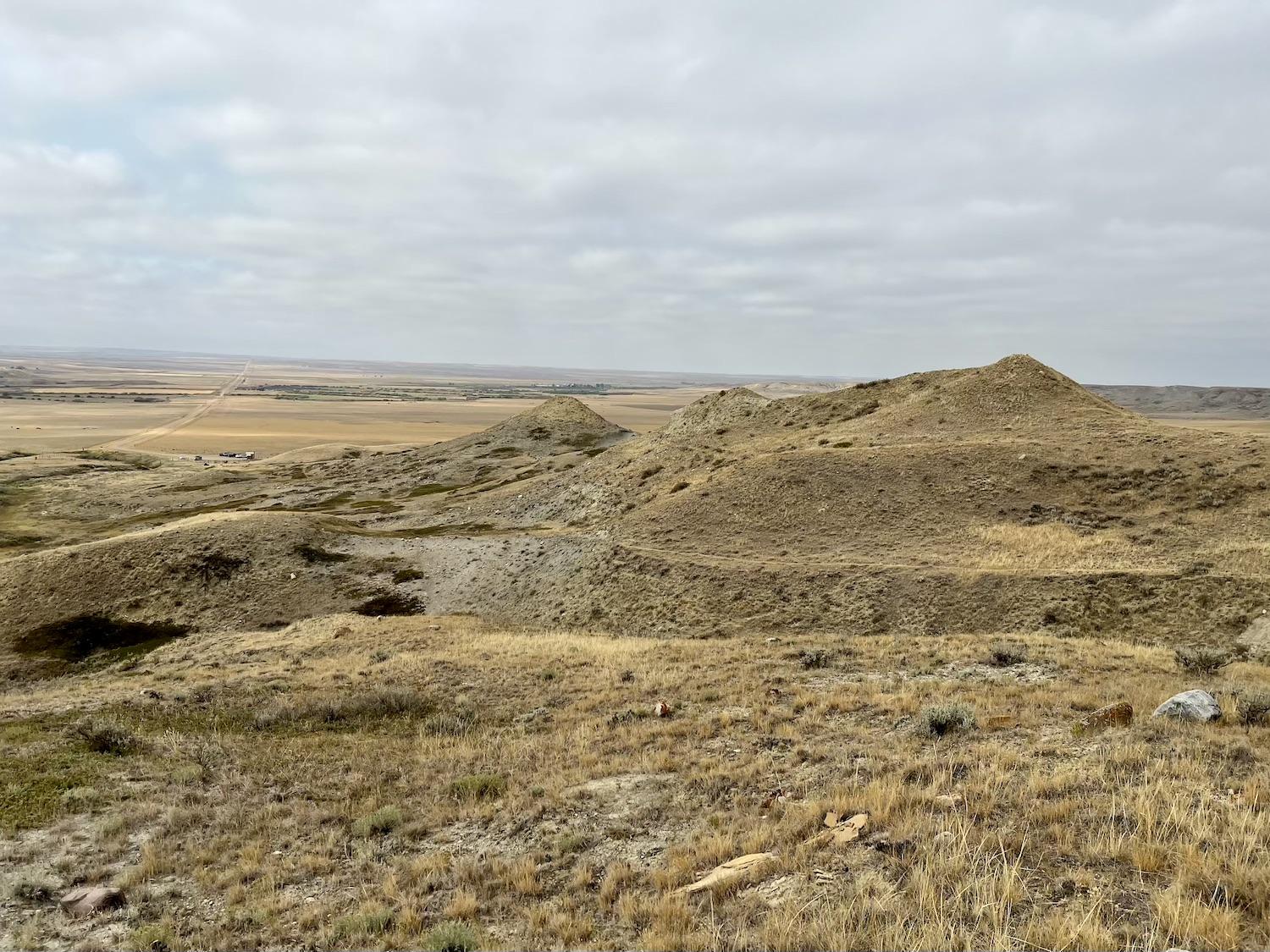
A view from Eagle Butte Loop Trail to the 70 Mile Butte parking lot in Grasslands National Park/Jennifer Bain
I’ve come to this park in southern Saskatchewan near the Montana border because it shelters nearly 70 per cent of the Canadian population of the Greater Short-horned lizards. August is the best time to see them, after the females have given birth, but it’s possible to spot them between late April and late September.
I say possible — not likely — because most people have never seen one and don’t even realize they live here in Grasslands. That said, GPS coordinates on Liccioli's phone show where lizards were found here in the park’s West Block last year, so when we meet at the 70 Mile Butte parking lot, things feel promising.
There's a montage of seven photos on the main trail sign. I note that it shows a lizard, but doesn't identify it or tell people how close they are to this rare species. The sign only tells visitors to expect to find “the edge of an ecosystem, an ancient sea bed, cultural features and rare plants and animals” on Eagle Butte Loop, 70 Mile Butte and Beapaw Sea trails. We wipe our shoes on a boot brush at the trailhead that has been set up so people don't carry the seeds of invasive species into the park, or track the species from this park on to another location when they leave.
Liccioli moves slowly across the greyish sandy terrain of bearpaw shale, swinging his walking stick over areas with rocks, pebbles and shrubby juniper.
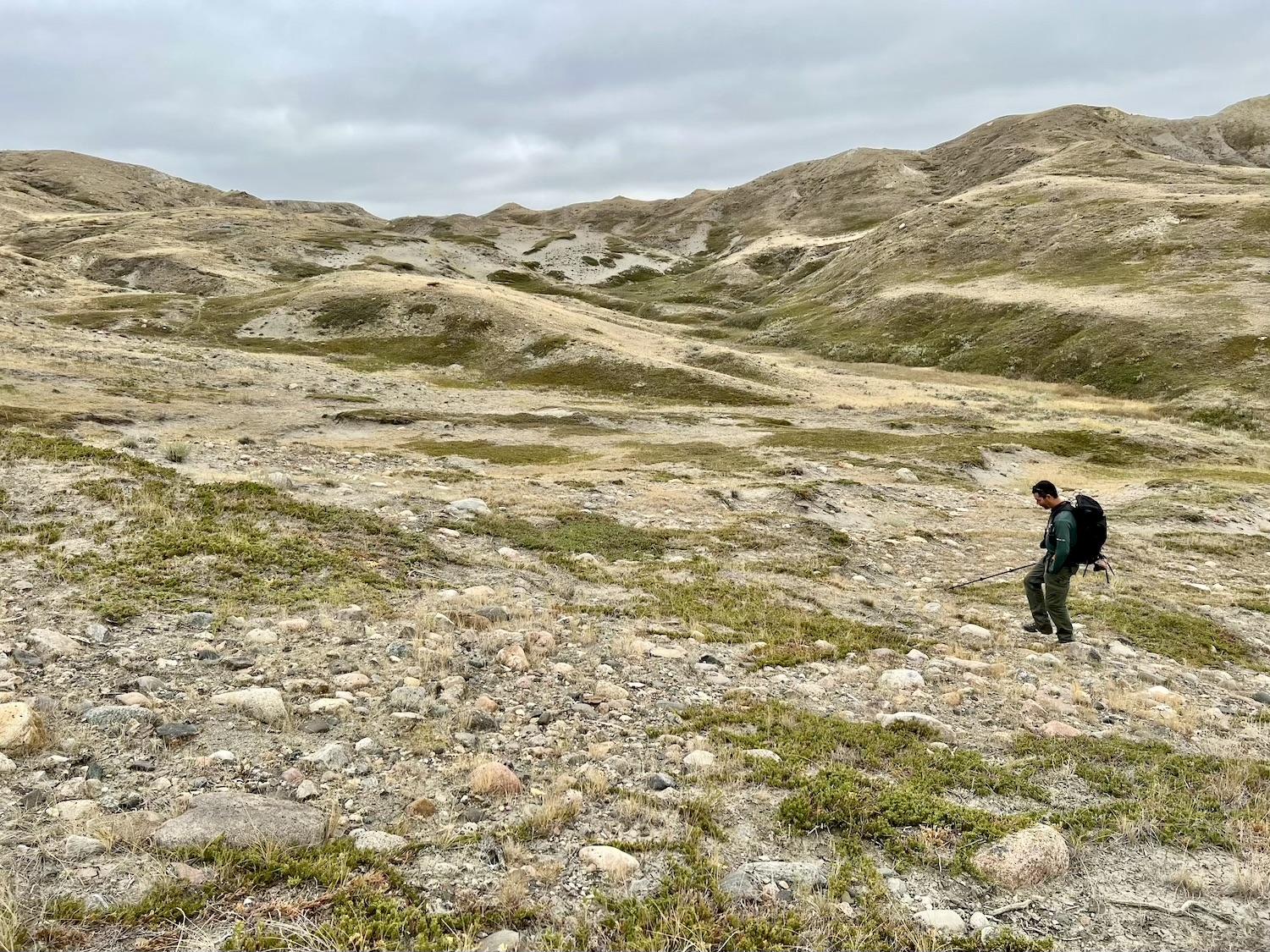
Parks Canada wildlife ecologist Stefano Liccioli uses a walking stick to search for Greater Short-horned lizards/Jennifer Bain
“The reason why I’m tapping and waving my stick is actually to flush the lizard,” he explains. “They will see the stick and will move and that’s actually when you get to see them, because they move. If they were to stay completely still, unless they were in a good spot with good lighting, it’s tough. They’re incredibly cryptic [camouflage well].”
The Greater Short-horned lizard (Phrynosoma hernandesi) famously squirts blood from its eye ducts when it feels threatened by predators, but the people who love the species don’t dwell on that.
Parks Canada says the small, flat and wide-bodied lizard is named after the many short “horns” on its head and body — but people around here actually call it by the regional nickname “horny toad.” It lives in the rugged sloped areas between upland grassland and coulee bottoms throughout the Northern Great Plains down into central Mexico. In Canada, at the northernmost edge of its range, it’s only found in four distinct areas in southeast Alberta and two small areas in southwest Saskatchewan, which are both inside Grasslands.
In Grasslands — the only national park in Canada that protects the prairie grasslands ecosystem — the low-profile lizards like the bearpaw shale slopes in the Frenchman Valley and the lower reaches of Rock Creek. Their ability to remain motionless and their coloring protects them from predators, like birds and snakes, and helps them ambush their prey
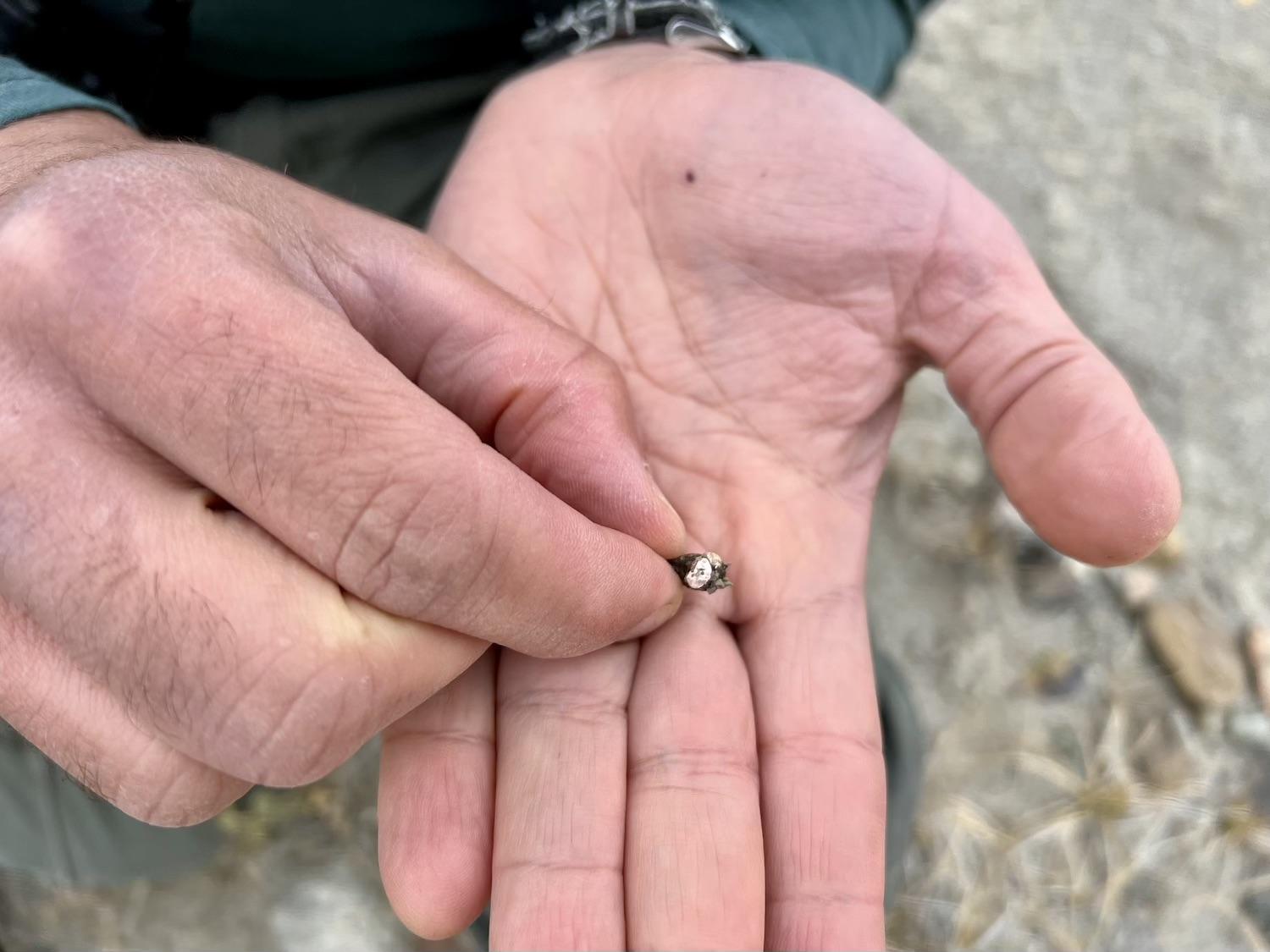
Greater Short-horned lizard scat looks like a Tic Tac/Jennifer Bain
Just 15 minutes into the search, Liccioli whoops.
“And I have found a poop,” he shouts. “You should take a picture a picture now then I’ll break it because I’m 100 per cent sure I want to crack it and see if it’s really anty inside. Maybe — yes, this is a cricket leg. So I’m pretty sure that’s a lizard poop which means there’s a lizard probably watching us. That’s the beauty of lizards. You know they are here and they drive you nuts. It’s like `where are you?’”
Where, indeed. My sister-in-law (another Jennifer Bain) and I allow ourselves to feel hopeful.
“One thing I will ask you now, I know I will sound paranoid, but really watch your feet because if you aren’t used to seeing a lizard, you might step on it,” Liccioli says excitedly. “I would really like you to mind your steps and maybe to try and step in my steps.”
Lizards eat a ton of ants, will grab other small invertebrates including beetles, spiders, grasshoppers and crickets. They also poop a lot. The feces is a single pellet that looks like a white Tic Tac with a white top. “It’s actually quite big for what you would expect from a lizard,” Liccioli points out. “They expel the acid that comes from ants. Ants have that acid, it’s one of their defences.”
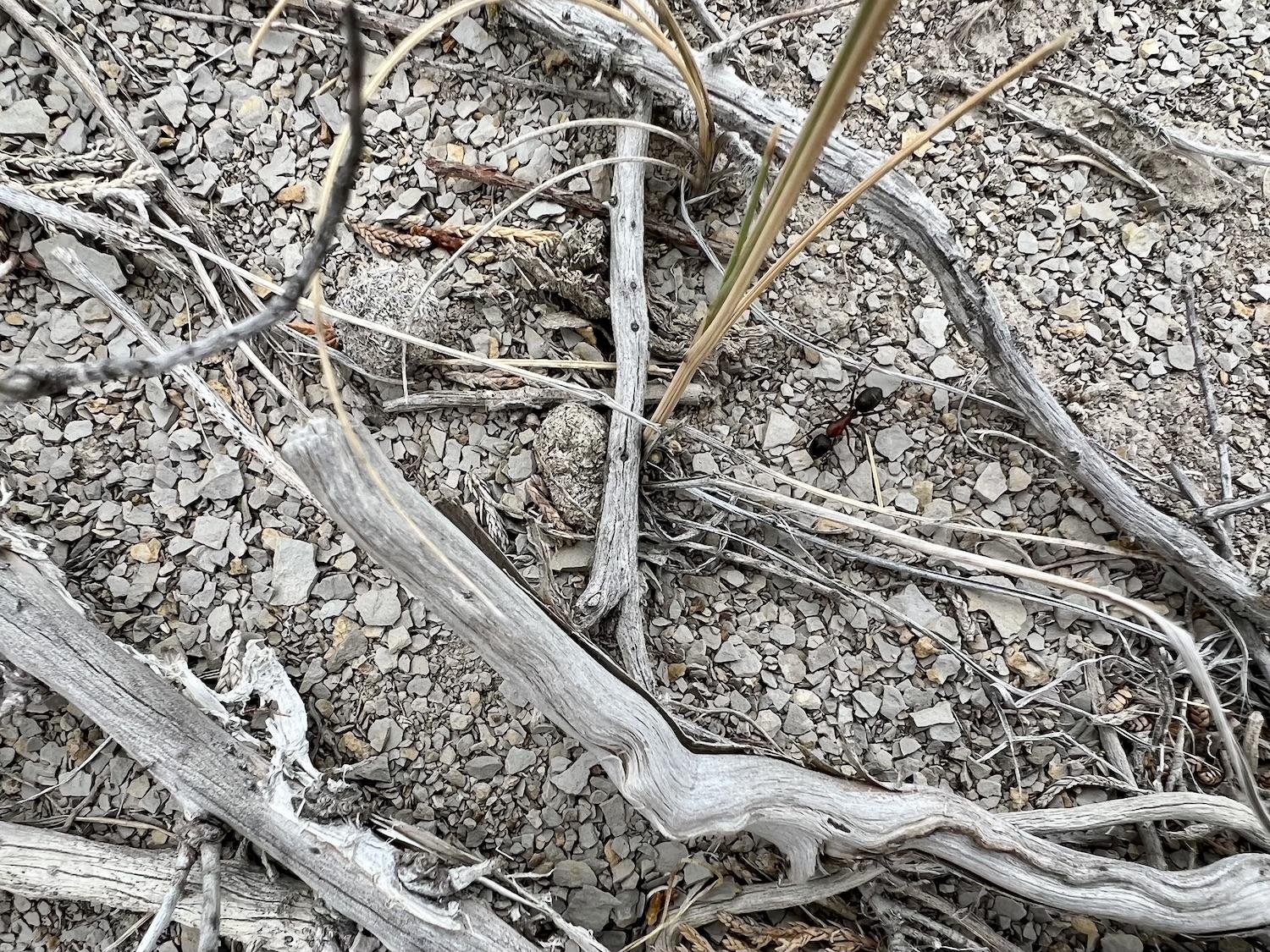
Ants are the favorite food of lizards in Grasslands National Park/Jennifer Bain
If we walk slow enough to see spiders and ants, we’re doing it right.
Liccioli didn’t bring his temperature gun but explains that lizards really depend on the temperature of the ground more than the temperature of the air. The Parks Canada team surveys for lizards annually, usually in August, and stop when it’s 30C (86F) outside the ground temperature hits 45C (113F).
“If it was really hot, they would definitely seek shelter under rocks. They’re pretty bulky lizards, but they can squish themselves and just flatten out so they really just adhere to the side of the rock. But because it’s cold, they probably won’t be seeking that type of protection," says Liccioli. “I would imagine now they are probably resting somewhere out right now, not underneath a rock, but around juniper in contact with the ground. It’s very remarkable when it’s sunny how quickly this place warms up.”
Indeed the sun is starting to burst through the clouds and warm things up.
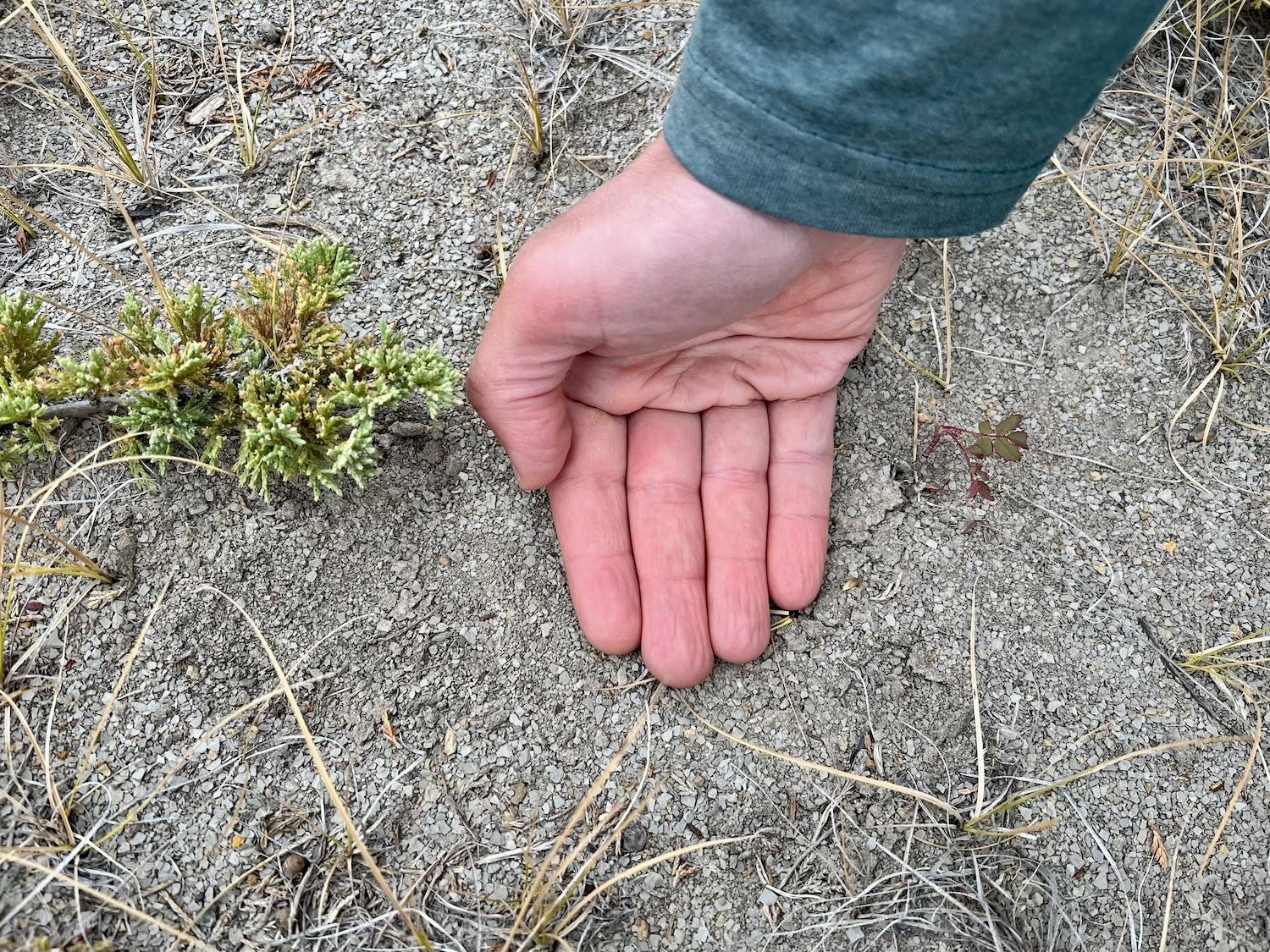
To find lizards, check the ground temperature not just the air temperature/Jennifer Bain
I tell Liccioli that I have seen a lizard once about 10 years ago. My husband ranched bison in Chin Coulee over the border in southeastern Alberta and apparently that’s one of the microclimates that supports these lizards. I stumbled upon one while I was out taking bison photos but didn't realize how significant the sighting was.
Here, Liccioli says, most people who see lizards see them by chance on the hiking trails. They definitely aren’t as high profile as the park’s prized Greater Sage-Grouse, an iconic grasslands species, or Black-tailed Prairie Dogs, which live in boisterous colonies. He figures they might be about a dozen lizards living in the area we’re now exploring.
But it's tough to get an accurate lizard count and Parks Canada monitors for “occupancy not abundance.” Within “lizard critical habitat,” staff monitor on a rotation schedule, looking at how many “blocks” are occupied by lizards and monitoring all the blocks over five years. They sometimes do a different kind of survey, writing a tiny number of the lizard’s belly with a Sharpie over the course of a multi-day survey. “It’s non-toxic, it goes away after a week or so but if you go out after a few days you can still read it,” explains Liccioli.
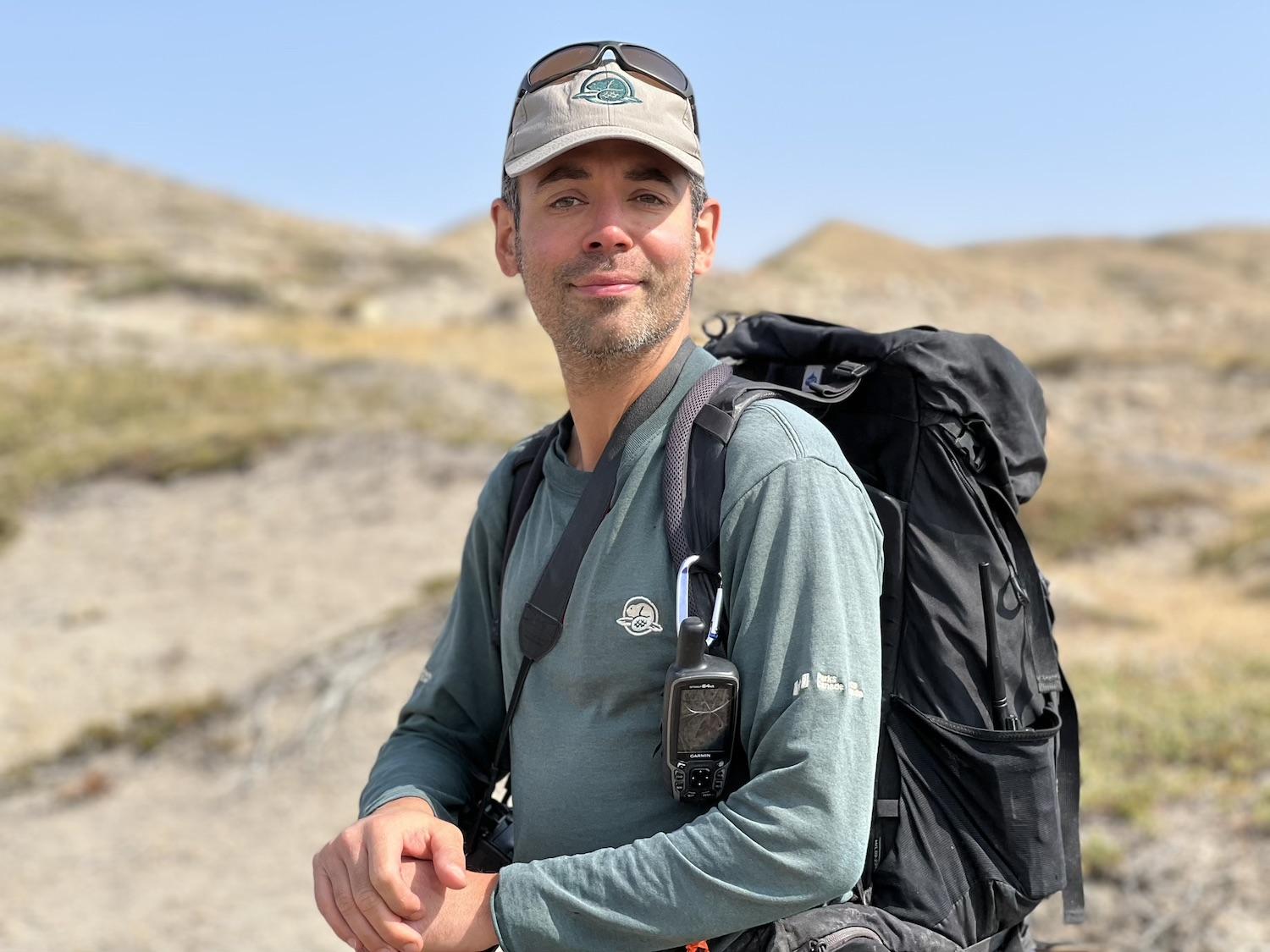
Stefano Liccioli is a wildlife ecologist with Parks Canada in Grasslands National Park/Jennifer Bain
So far, the Grasslands lizard population has been fairly stable. “In Canada if something were to happen to this population, it would definitely be significant,” Liccioli warns.
Females are much larger and plumper than males and have limited home ranges. Males are smaller and roam further. As for that defense mechanism where they can shoot blood from their eyes, that’s even rarer to see than the actual lizard. “We capture and handle about 20 lizards a year,” says Liccioli, but “the blood, actually, I haven’t seen it myself.”
What he finds most remarkable is how the lizards can survive in 40C (104F) summer heat and minus 40C (minus 40F) winter cold. His Parks Canada colleague Nick Cairns is currently researching the wintering habitat for the lizards who will bury themselves under about 10 centimetres (4 inches) of loose soil on south-facing slopes. He has written about the lizards for the Canadian Encyclopedia.
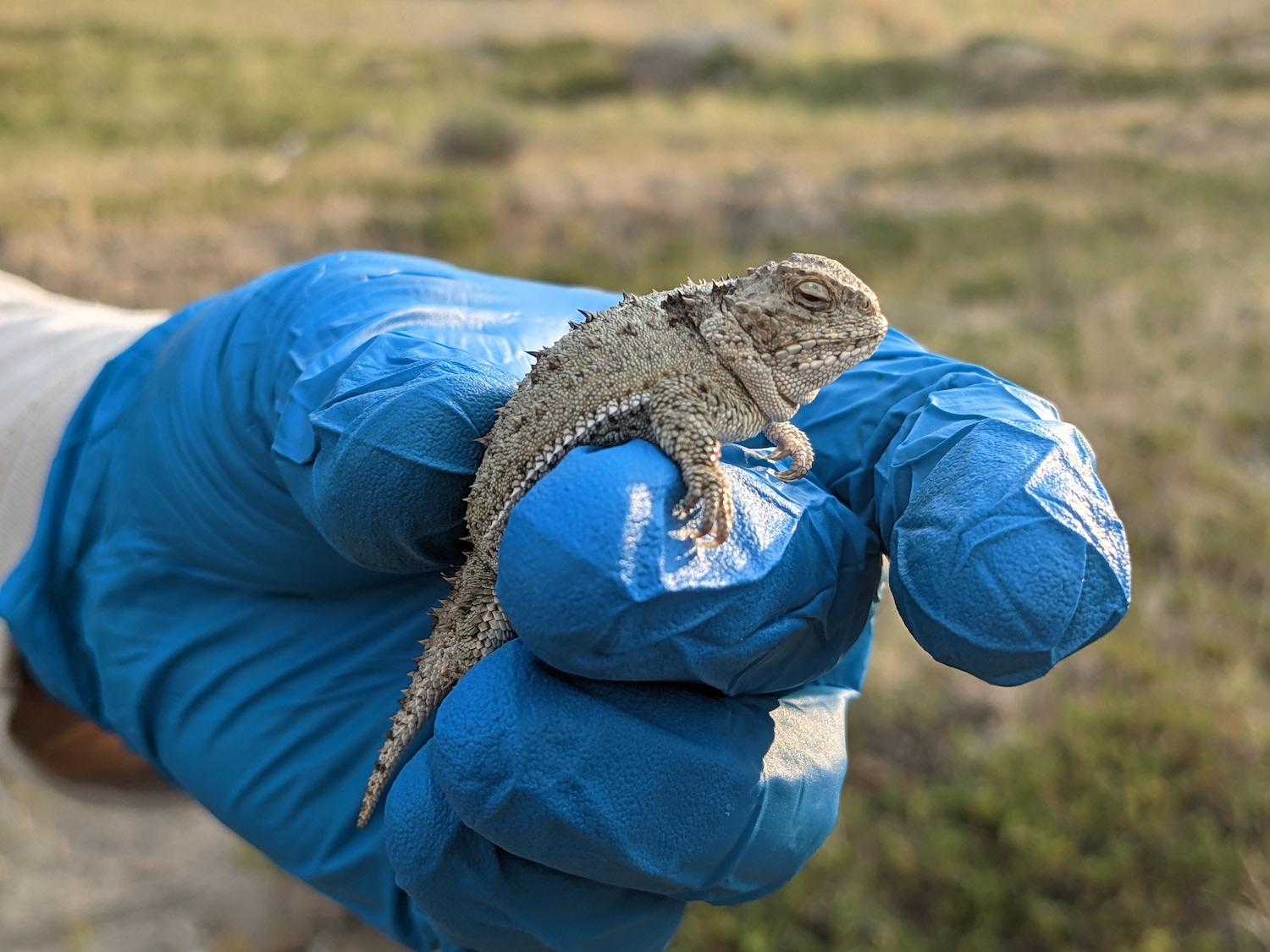
Parks Canada researchers are gentle when they do lizard surveys/Parks Canada
Parks Canada says lizards seek sites that accumulate snow for brumation (a cold weather sluggishness that's similar to hibernation) because snow helps stabilize temperature. In dry parts of the Canadian prairies, like here in Grasslands, there isn't much snow and much of it quickly blows away or melts.
More than an hour passes and we haven’t progressed beyond the lizard scat to an actual lizard. We have admired a couple of jackrabbits, though, and decide it’s time to switch gears and look in a rocky area for rattlesnakes.
“Usually when I stop looking for the lizard, I find it,” says Liccioli, whose main passion is wildlife conservation.” Among the 30 species at risk in the park, the lizards, Greater Sage-Grouse, Black-tailed Prairie Dogs, Prairie rattlesnake and Burrowing Owls are all considered high priority.
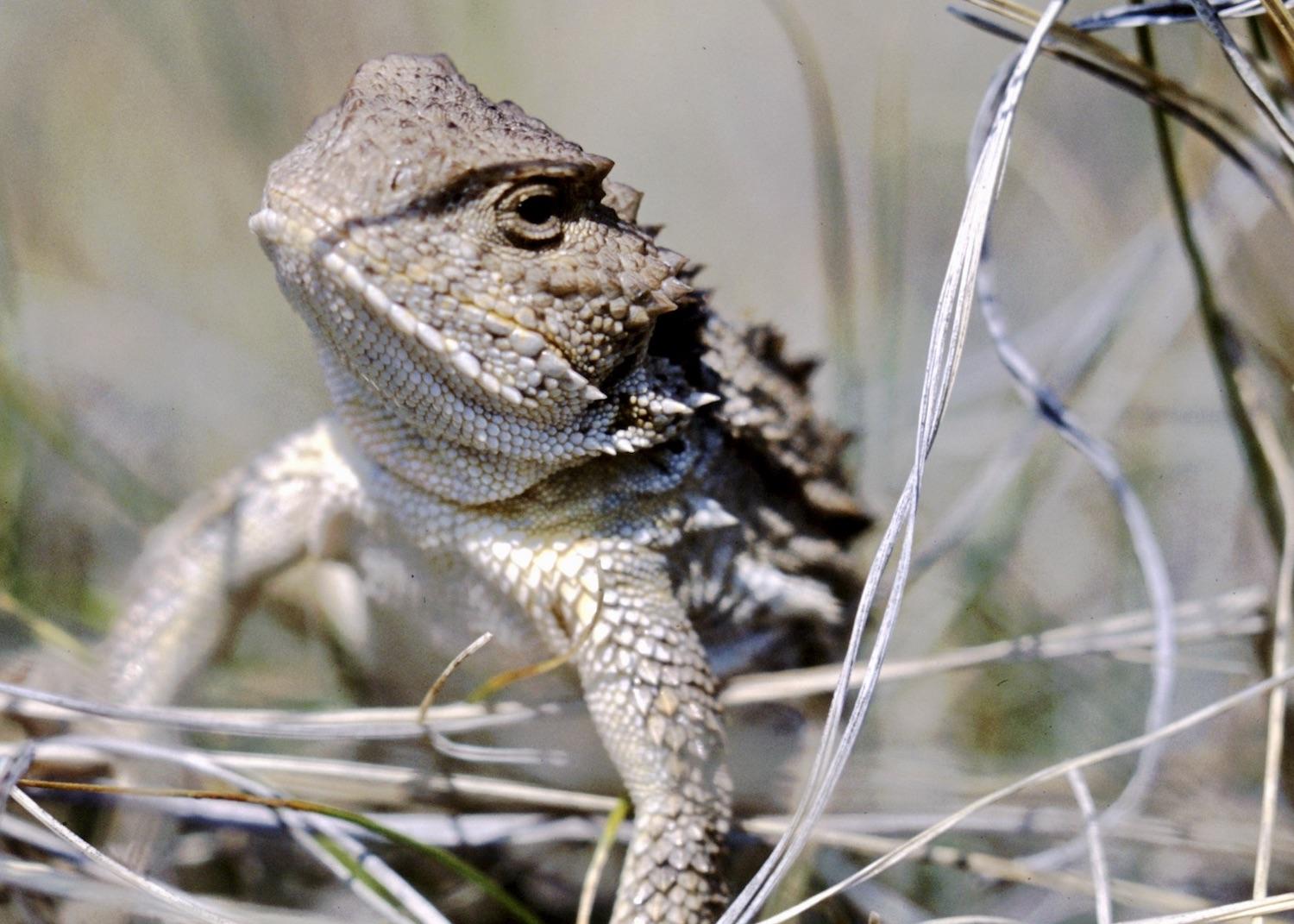
Greater Short-horned Lizards may shoot blood from their eyes when threatened, but that is rare to see/Parks Canada
In Grasslands, intensive surveys for this species date back to 1996. Since 2018, the park has been conducting annual localized surveys for occupancy. Between 2018 and 2022, Grasslands staff surveyed about 526.7 kilometres (326 miles), finding 75 adult and juveniles, plus 84 neonates (newborns). The overall average rate of detection is just 0.15 adult lizards/kilometre.
Threats include the conversion of native habitat to crop and forage production, high-intensity prolonged grazing, invasion and establishment of exotic plants, and inclement or extreme weather conditions. Loggerhead Shrikes have been known to grab lizards and impale them on a fence to stabilize it while they feast on the flesh.
Our time with Liccioli is soon up and we strike out.
“A lizard poop is just as diagnostic as a lizard,” he tells us, but it's not much of a consolation prize.
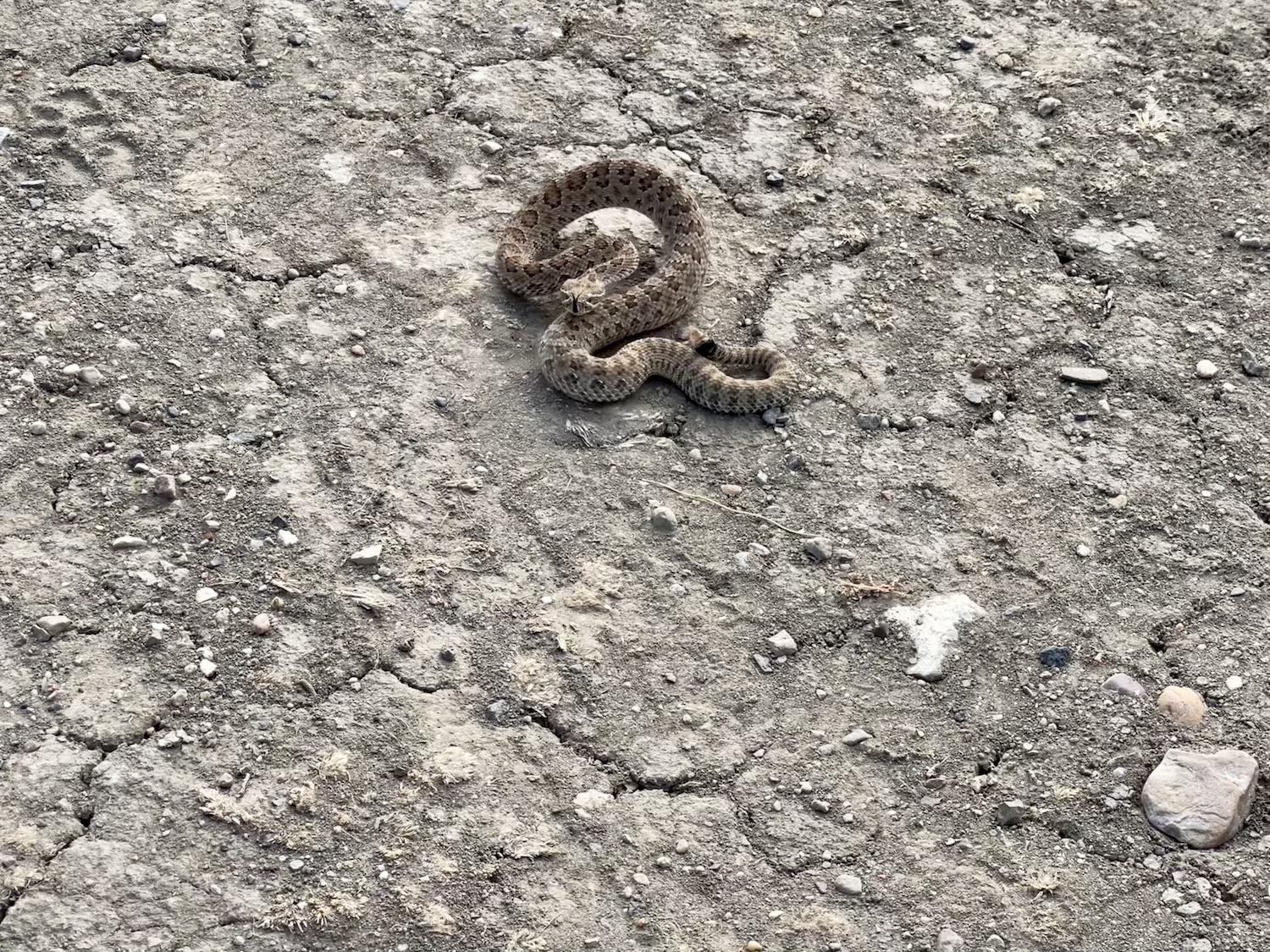
We didn't find lizards but did spot this Prairie rattlesnake in the parking lot/Jennifer Bain
We part ways with him and linger over a picnic at the trailhead, wishing we had a full day to devote to lizard hunting instead of just a few hours before moving on to the East Block of Grasslands, the Badlands Parkway and the epic hike known as Valley of 1000 Devils.
"Over here," my sister in law shouts, waving me over to the parking lot. "Come quick."
There, just steps from our car, is a young rattlesnake. I lock eyes with the snake and start taking photos from a respectful distance. The snake coils and shakes its rattle for a few seconds before slithering away and diving into a hole.
"Got the rattler," I report in a triumphant email to Liccioli. "Right behind our car at the parking lot."
"Ha, nice," he replies.



Add comment